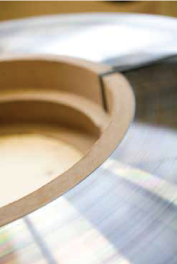FLEXO 101
It’s What’s Inside That Counts:
Analyzing Doctor Blade Composition & Material Makeup
Fifth in a 5 Part Series on The Importance of Basic Process Element
In the age of HD flexo printing, choosing the right doctor blade “material” can be confusing and a challenge. Here’s why: Suppliers offer many material choices, including:
- Carbon steels
- Stainless steels
- Tool steels
- Specially alloyed steels
- Coated steels
- Plastic
Not all of these materials are equal to the task of achieving precision ink metering on an anilox roll to create the perfect ink film. Here’s a short assessment of what’s out there. But first: As you read this, keep in mind we’re talking about doctor blades and not containment blades for use at the higher end of flexo, when aniloxes routinely exceed 1,000 lpi and plate screens range from 133 to 175 lpi.
PLASTIC VS. STEEL
The first big choice is between plastic and steel. Plastic and synthetic materials are most frequently used in non
critical flexo print or coating applications, such as when printing on corrugated board and Kraft paper sacks. The composition of plastic and synthetic materials can include some combination of ultra high molecular weight polyethylene, polyolefin, polypropylene, polyvinyl chlorides, polymers, fiberglass, nylon—the list goes on. While these materials can offer long life and perform well in a variety of industrial applications, they fall short on the following critical points when used as a doctor blade to achieve precision ink film metering when compared to steel:
- Inability to achieve thinnest ink film due to poor overall rigidity
- Inability to achieve and maintain a consistent nick free edge during run
- When reduced to 0.006″ or 0.008″ thick tip, the edge can soften and deform
- Hard ink borne debris can embed into plastic, causing streaks and anilox damage
- Plastic resins embed into anilox ceramic, altering critical dyne levels
- Sustainability: According to the EPA’s website, in 2012 only 9 percent of all plastic waste was recycled

Steel doctor blades are used by a majority of flexographic and rotogravure printers around the world. Doctor blades are made from strip steels. They are made using an electric arc furnace (EAF) process, which uses nearly 100 percent recovered steel. The base composition is iron and carbon. Other elements such as chromium, nickel, molybdenum, tungsten, vanadium can be added to the melt’s chemistry to achieve desired application specific performance, such as resistance to wear, abrasion, temperature and so on.
In addition to chemistry, strip steels are processed through various treatments, such as hot rolling, cold rolling, hardening and tempering. How these treatments are preformed, how much pressure is applied or to what temperature the strip is brought to is as important to the end result as the chemical ingredients. Strip steel is manufactured in very large quantities—often several tons. The end result is a product that is extremely consistent within its own batch and from batch to batch. Strip steel’s advantage over plastic and synthetic materials are:
- Steel can achieve and maintain a thinner contact area as compared to plastic materials, resulting in a thinner ink film and reduced occurrence of dot gain
- As material wears, the structure and density remain constant
- Wear generated debris easily migrates in ink without altering ceramic dyne levels
- Sustainability: According to the EPA’s website, up to 95 percent of steel is recycled. Most strip steels used to make doctor blades are made from 100 percent recycled materials
MODIFIED STEELS
Different steel types have also been developed to meet changes and challenges of the flexo ink transfer process. Here is a short review of these materials:
- Carbon Steels – The lowest cost type of steel strips with a refined microstructure. They tend to perform well in shorter run applications, especially when a blade is not to be reused on another job
- Stainless Steels – Offer deformation resistance in corrosive applications and improved resistance to wear, especially against lower line count anilox and coating rolls
- Tool Steels – These achieve superior wear resistance. It’s important to be sure the microstructure is super refined as hardness is increased
- Specially Alloyed Steels – Through chemistry, achieves reduced abrasion and less anilox wear
- Coated Blades – When applied to a high quality base steel, blade coatings can extend blade life considerably, especially in hostile environments such as varnish coatings
SAFETY & MATERIAL SELECTION
All doctor blades have the potential to cut a person when being handled, including radius edged steel and plastic materials. Common sense and best practices that include the use of cut resistant gloves when handling a blade allow the majority of pressrooms to operate for years without finger and hand cuts.
Many doctor blade suppliers offer a full range of blade materials, including all that are mentioned here. It makes sense to know what material you now run and if you are considering making a change, know what you hope to gain by doing so. Your supplier should be able to assist in a controlled material evaluation to support your decision.
In conclusion, using the right doctor blade material in combination with the right dimension and edge can reduce or eliminate many print defects like dirty print and dot gain. It’s also possible to eliminate back doctoring, reduce end seal leaking, avoid mid run press stops and achieve an increase in press speeds. When all is said and done, at whatever price, a doctor blade can more impact a press run than almost any other process element. Choose wisely!
If you need help with assessments or training for the best doctor blade solution, contact one of our experts for a consultative evaluation. Our team will be able to help you with solutions.
Download Technical Article
It’s What’s Inside That Counts (5 of 5)
